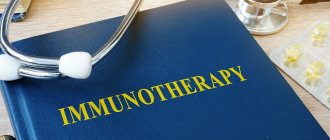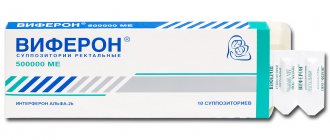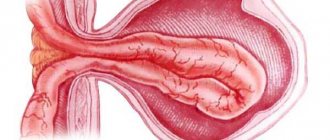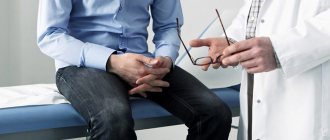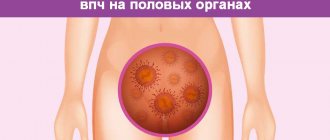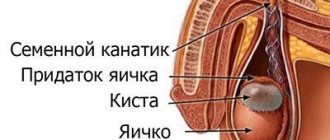August 9, 2021
Athlete's inguinal rash is a fungal infection of the skin with a red rash and itching that forms in deep folds. In medical practice, the term “mycosis of large body folds” is also used - this is a similar diagnosis, but it implies the addition of several classes of fungi and the appearance of lesions not only in the groin area.
Pathogen and routes of infection
The causative agent of athlete's foot is the parasitic fungus Epidermophyton floccosum. In the acute phase, the disease is contagious and is transmitted in the following ways:
- autoinoculation - transfer of the fungus from the source of inflammation on the arms or legs;
- indirect route - infection through household items on which there are scales of the epidermis with a pathogenic fungus: clothing, towel, sheet, seat;
- direct – transmission from a carrier during sexual intercourse.
Risk factors contribute to the active development of epidermophytosis of the inguinal folds:
- high humidity and local hyperthermia - the peak incidence is observed in residents of tropical and subtropical climates in the summer;
- tight, dense clothing that does not allow air to pass through - synthetic materials with thick thread;
- increased sweating;
- obesity, diabetes mellitus, immunodeficiency states;
- gonorrhea;
- chlamydia;
- mycoplasmosis;
- trichomoniasis.
In men, such damage to skin folds occurs 3 times more often than in women, according to incidence statistics in the United States.
Treatment of inguinal hernia - types of surgery
Doctors operate on hernial protrusions in the groin area using the most modern techniques, choosing the type of intervention that is optimal for the patient. And just two or three decades ago, tension repair was considered the only and main surgical method (the opening of the hernial orifice was “covered” with flaps formed from the tissue of the patient’s abdominal wall). Now they are moving away from this method: it involves a significant number of side effects and cases of recurrent hernias.
Thanks to progress, surgery is shifting towards gentle, innovative operations. The technologies for removing indirect and direct inguinal hernias used in hospitals and clinics are much more effective, less painful, and less long-term in terms of rehabilitation. The use of artificially synthesized materials minimizes rejection reactions. What hernioplastic measures are there to eliminate the pathology quickly and harmlessly:
1. Tension-free method according to Liechtenstein . They use “tension-free” plastic surgery, one in which the material involved – a polymer synthetic mesh – does not require tension and is not rejected by the body. There are already 3D varieties of mesh. Through an incision in the groin, the resulting hernia is reduced or removed, after which an onlay is made instead of the hernia orifice. The surgeon installs a mesh implant in their place with a hole for the spermatic cord and attaches it to the abdominal cavity. The patient can go home a few hours after the operation! Over time, the mesh becomes part of the body. The material under the skin is intertwined with natural tissues and acts as a frame that supports the organs. The downside of the technique is that a small scar remains visible at the incision site.
2. Laparoscopic suturing . They practice the most effective and low-traumatic method of hernia excision - laparoscopic inguinal hernia repair. There is a limitation - it cannot be used in cases where the hernia has become very large.
This operation requires general anesthesia. The technique involves making three neat punctures in the anterior abdominal wall. An instrument is inserted laparoscopically through them and an auxiliary substance, carbon dioxide, begins to be pumped. First, under the influence of gas, the wall of the peritoneum is stretched, and then it is possible to move the hernial sac into the abdominal cavity. Using instruments introduced into the patient’s tissue, the surgeon closes the hernial orifice from the inside with a mesh polymer “patch,” and the excess internal tissue is sutured.
3. Endoscopic surgery . It is recognized in the medical world as the safest and most effective, as it is performed with local anesthesia (rarely with general anesthesia). Tissue damage is minimal, there will be no scar marks on the skin. It can be argued that this is rather a masterly reduction of the protrusion under local anesthesia. Feature - mesh retaining material is implanted between the layers of the abdominal wall. A self-supporting effect is created due to natural pressure in the peritoneum. The progress of the process is monitored by an endoscope, and the surgeon’s actions are broadcast by a video camera on a screen with multiple magnification.
Surgery and rehabilitation for inguinal hernia
Manipulations to eliminate an inguinal hernia in men on the left or right are considered easy for both patients and surgeons - a small surgical field is involved, large incisions are not required. The maximum is done to remove the hernia and prevent its recurrence. As a result of the intervention, doctors surgically remove the protrusion (hernial sac), returning the displaced viscera, vessels and lobes of human tissue to the desired “correct” position. After plastic surgery of the hernial orifice, a polypropylene endoprosthesis-mesh made of synthetic threads serves as support for the inguinal canal and the peritoneum as a whole, and in the future does not interfere with leading a normal, familiar life.
In order to eliminate postoperative complications, it is necessary to remember and carefully follow the doctor’s recommendations:
- take only medications prescribed by the doctor orally and externally;
- bed rest in the first days (up to a week),
- stop smoking and do not drink alcohol;
- adhere to dietary nutrition,
- carefully begin physical activity;
- use the breathing technique “abdominal breathing”;
- keep the incision/puncture site clean and change bandages;
- after removing stitches and bandages, wear and often change underwear made of natural material, ironed with a preheated iron,
- avoid rooms where the temperature, concentration of dust, and humidity are high;
- do not allow any intimate contacts earlier than 14-20 days;
- The first sexual intercourse after surgery should be performed in a gentle manner, without squeezing the hernia area.
The operation in commercial clinics is estimated in the range of 25-90 thousand rubles. The cost consists of the type of manipulation chosen (laparoscopy is the most expensive), medical supplies, anesthesia used (local, epidural or general), the size and location of the hernia, and the qualifications of the operating specialist.
Symptoms of inguinal athlete's foot in men
Fungal infection begins with an acute phase, which becomes chronic in the absence of timely treatment. Characteristic manifestations:
- symmetrical pink, reddish spots with a clear outline;
- peeling of the affected area of skin;
- ring-shaped lesions with edematous inclusions of bright red color, consisting of vesicles, pustules, papules;
- pain with any physical activity.
Rapid peripheral growth forms lesions up to 15 cm in diameter. Athlete's foot in the groin area involves the scrotum and inner thigh, but lesions on the skin of the penis are not observed.
Rash in the groin of a child
The appearance of rashes of various shapes and structures in the groin area of a child indicates the occurrence of a pathological process. This phenomenon can occur for various reasons. Parents are required to understand that the presence of a rash can be associated not only with dermatology, but also with other more dangerous diseases.
The skin of children is most sensitive to extraneous irritants that affect the body, both from the outside and from the inside. Groin rashes are common in the first twelve months of a baby's life and can often be resolved with better personal hygiene and the use of specialized creams.
Other causes of rashes include:
- allergic reaction;
- disturbances in the functioning of the endocrine system;
- intestinal dysbiosis;
- prickly heat or scabies;
- fungal infection of the skin in the groin;
- eczema;
- diaper dermatitis.
Such manifestations can be a sign of more serious pathologies. Therefore, if the rash is localized in the groin of a child, you should undergo a more thorough examination, which will be prescribed when you consult a doctor.
Answers to frequently asked questions about skin rashes:
- Which doctor should you contact for a skin rash?
- Is the skin rash contagious?
- What diet is necessary for skin rashes?
- What diagnosis is needed for a skin rash?
- Why is a skin rash dangerous?
- Why is it necessary to get tested for a skin rash?
- What diseases does a skin rash indicate?
- What examination is necessary for a skin rash?
- Which skin rash is dangerous?
- How to distinguish an allergic rash from an infectious one
- How to get rid of skin rashes?
- How to get rid of itching skin rash?
- What organs are affected by a skin rash?
- How to prepare for an appointment with a dermatologist?
- How to get checked for skin diseases?
- What diseases does a dermatologist treat?
- What tests should be taken by a dermatologist?
- What diagnostics can a dermatologist perform in the clinic?
- Where to go with a skin disease?
Stages of development
Initially, the disease does not manifest clinical symptoms - the incubation period lasts up to 3 weeks. Then the first signs appear and rapidly develop - from a couple of weeks to several months.
Further scenario for the development of the disease:
- chronic form with frequent relapses is the most common option;
- asymptomatic carriage - determined only by laboratory diagnostics;
- Spontaneous healing is an extremely rare case.
If you do not contact a venereologist in time, athlete's foot will bother you for years, becoming especially severe in the summer.
Treatment of fungal skin diseases
The cause of dermatomycosis is infection by pathogenic microorganisms. For a person to get sick, contact with infected objects is enough - shoes, towels, washcloths, and so on. The risk of infection is high in people who suffer from sweating feet, varicose veins, diabetes, endocrine disorders and other diseases that reduce immunity.
In our “Polyclinic +1”, appointments are conducted by first category doctors V. A. Malashenko and R. A. Guseinov. They have specialties such as dermatology and mycology. Each of these doctors has many years of practical experience, so they are able to cope with the most difficult cases.
We offer several types of tests for pathogenic flora. Scrapings from the affected area are studied using various methods, including:
- microscopy;
- PCR;
- sowing on nutrient media.
These studies will allow you to identify the fungus, determine its type, and find out what drugs it reacts to.
After this, our doctors draw up a treatment plan for the fungal infection. We practice an integrated approach, so we combine tools that solve different problems:
- destroy harmful microorganisms,
- strengthen the immune system;
- heal the skin.
The duration of therapy depends on the severity of the disease, the body’s resistance and other factors. In any case, our specialists monitor the process and, if necessary, adjust the assignments.
Diagnostics
The doctor evaluates the clinical picture and prescribes instrumental and laboratory tests:
- microscopic analysis of a preparation of scales;
- bacteriological culture;
- polymerase chain reaction;
- Wood's lamp examination.
During the differential diagnosis, the venereologist excludes pathologies such as erythrasma, neurodermatitis, herpes virus, allergic and seborrheic dermatitis, candidiasis.
The Center for Urology, Gynecology and Reproductology in Moscow carries out laboratory and differential diagnosis of inguinal epidermophytosis with further treatment.
For severe itching and burning - antihistamines
For inguinal fungus, local treatment is usually sufficient, but oral antihistamines may be prescribed to relieve itching and discomfort:
- Loratadine;
- Clemastine;
- Chloropyramine;
- Cetirizine.
Solutions of silver nitrate and resorcinol, ointments with betamethasone and clotrimazole are used as local remedies. Medicines such as Terbinafine and Undecylenic acid show good results.
The course of antimycotic therapy lasts a month and a half and continues even after the symptoms disappear. The affected areas are also lubricated with iodine or Fucarcin.
If the skin becomes very inflamed, then apply lotions with Ichthyol and brilliant green. Ichthyol ointment 5-10% is applied to the area of the inguinal folds 2-3 times a day, Diamond Green - 1-2 times. Inflammatory reactions pass quite quickly, within a maximum of 2 days.
Treatment options
Only based on the test results can it be stated that the inguinal fold is affected by epidermophytes. Treatment of inguinal athlete's foot in men consists of the following areas:
- etiotropic: fungicides, fungistatics to combat the cause of pathology;
- symptomatic: drugs to eliminate itching, discomfort, cosmetic defects;
- pathogenic: to eliminate risk factors.
The treatment regimen is prescribed only by a specialist. He will assess the presence of a secondary infection, the stage of the disease, and prevent its further spread.
Rash in the groin in pregnant women
During pregnancy, hormonal imbalances are observed, which contributes to the formation of rashes of various types in the intimate area of women. Such manifestations include:
- prickly heat, which is formed as a result of excessive sweating and moisturizing of the skin in the groin area;
- rashes in the form of red spots, plaques and papules, often accompanied by itching, usually go away on their own after childbirth;
- infectious manifestations in the form of purulent formations, if there is a hidden sexually transmitted disease;
- small pimples that do not cause any discomfort and are not harmful to the pregnant woman or child.
Diaper rash can also form due to increased body weight in the most sweaty areas of the body, including the groin. In such cases, a fungus may appear, which will subsequently lead to an infection followed by an inflammatory process.
Any changes or concerns should be reported at regular examinations with a gynecologist, which must be regularly attended throughout the entire pregnancy.
Possible complications
If athlete's foot in the groin area is not treated, cosmetic defects and complications are possible. The first includes hardening of the affected area of skin, like a callus. Complications include the addition of a secondary infection, which, depending on the pathogenesis, can affect the penis and urethra.
Differential diagnosis and treatment of athlete's foot in adults is carried out by specialists from the Dr.AkNer clinic in Moscow. Get professional help to prevent complications from a fungal infection. Effective painless techniques, proven by 40 years of experience.
Urologist, andrologist Akopyan Nerses Grigorievich.
Back to list of articles
Who is at risk: causes of the disease
The optimal conditions for the development of fungal infections are heat and humidity. Male professions (driver, military man) oblige a person to wear warm, unventilated clothes for long hours, day after day creating an optimal habitat for the causative agent of the disease.
A weakened body, the presence of mycosis on other areas of the skin, contact with people who are carriers of mycoses, metabolic disorders are factors that increase the risk of epidermophytosis.
Knowing the causes of the disease, we can identify the main categories of men who are at risk:
- elderly people;
- patients with diabetes and (or) obesity (treated and advised by an endocrinologist);
- men with hyperhidrosis (this means profuse, uncontrollable sweating);
- people with immunodeficiency;
- drivers, military, police, rescuers, etc.
Why is it important to see a doctor?
There are many causes of groin pain, and the nature of the symptom can only be determined after a thorough diagnosis.
Self-medication can make the problem worse, so it is important to see a doctor as soon as possible. The State Urology Center provides qualified medical care under the compulsory medical insurance policy, so the procedures and treatment prescribed by the doctor will be free for you. First, sign up for a consultation with a specialist, then we can relieve you of unpleasant symptoms and restore your health. April 19, 2021
Hakobyan Gagik Nersesovich - urologist, oncologist, MD, doctor of the highest category, professor
All the symptoms of the disease...



